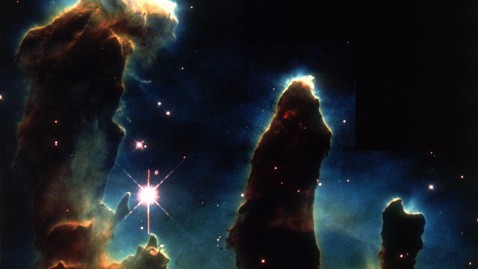NASA Gets 2 Unused Space Telescopes From Spy Agency

Hubble Space Telescope image of 'Pillars of Creation' star nursery. Space Frontiers/Hulton Archive/Getty Images
Free while they last: Two space telescopes, unused, ready to be fixed up for the mission of your dreams. Recipient must be willing to handle transportation and storage.
It wasn't quite like that, but NASA said it was close. It got a call, it says, from the National Reconnaissance Office - the folks who handle the nation's spy satellites - offering two telescopes it had built but never used. They were already finished. They had terrific optics - each one as powerful as the Hubble Telescope. And NASA was welcome to them, said the NRO, since they were going to waste at their factory in Rochester, N.Y.
"About a year and a half ago, I literally got a phone call," said Michael Moore, NASA's acting deputy director for astrophysics. "They said, 'We have some hardware we need to dispose of or let someone else take advantage of."
"This hardware was deemed no longer needed for intelligence missions," said Loretta DeSio at the National Reconnaissance Office. The two telescopes, she said, had been built in the late 1990s and early 2000s. Their existence was classified until just recently.
The NRO could presumably have used the two instruments to look down on Earth from orbit, but it's not such a simple matter to turn them around to look at the cosmos. For starters, they're not complete spacecraft - just two identical telescopes precision-made to fly in orbit. Before you launched one, you would need to add cameras, solar panels, a control system, a rocket to get it into space - all pretty basic, and expensive, stuff.
NASA has quietly been querying astrophysicists for input on how to best make use of the two telescopes. One thought is to use one for a planned project called WFIRST - a space observatory that would scan the sky in infrared light, looking in particular for clues about dark matter, material that may make up much of the universe but is so far poorly understood.
The earliest NASA managers said they could imagine launching one telescope would be in the year 2024 - and that's if Congress approves funding.
"We don't ever anticipate being rich enough to use both of them," said Paul Hertz, NASA's astrophysics division director, "but it sure is fun to think about."
One thing the two telescopes will not do is gather dust. They're in a clean room at the Exelis company in Rochester, where they were made. NASA has taken over the cost of keeping them clean - and even that carries a price tag of more than $75,000 per year.
But if the two space telescopes can be put to good use, said Moore, they could save NASA more than $1.5 billion.
"Right now they just look like cylinders with shiny foil wrapped around them," said Moore. "I personally think they're gorgeous, but that's because I'm an engineer who builds space telescopes."